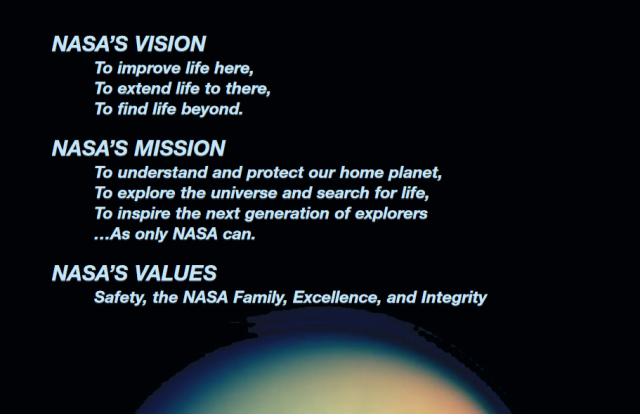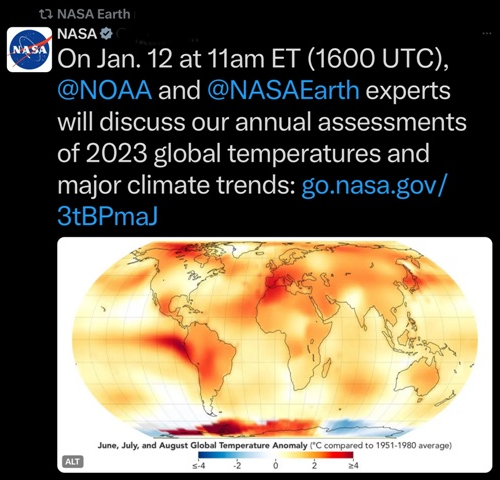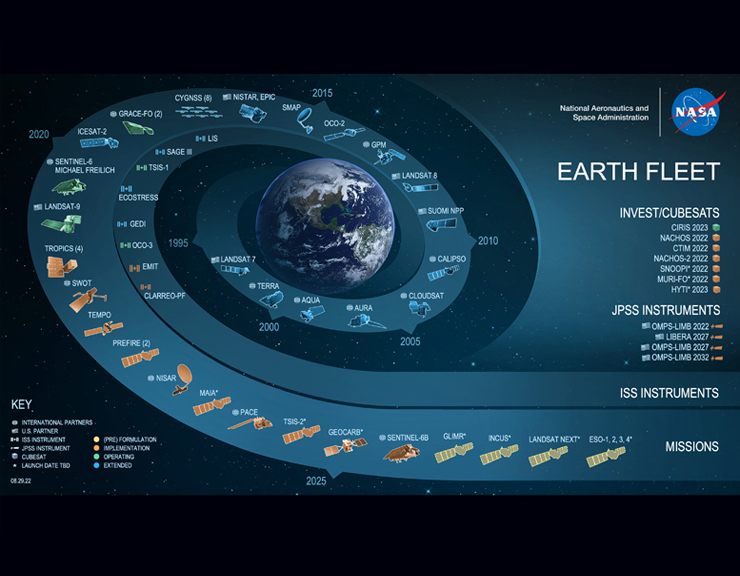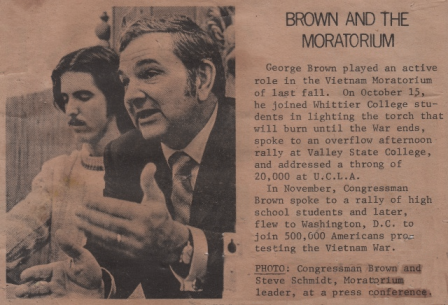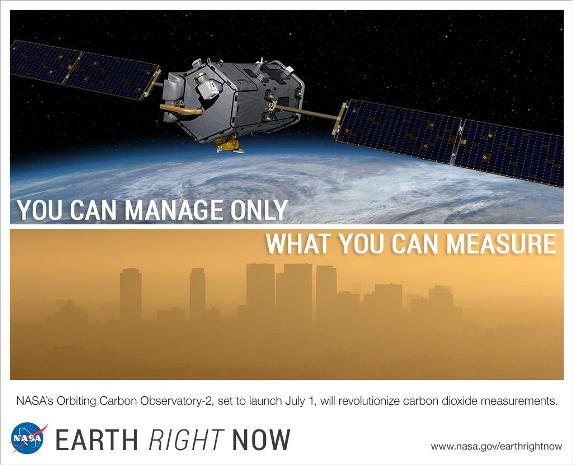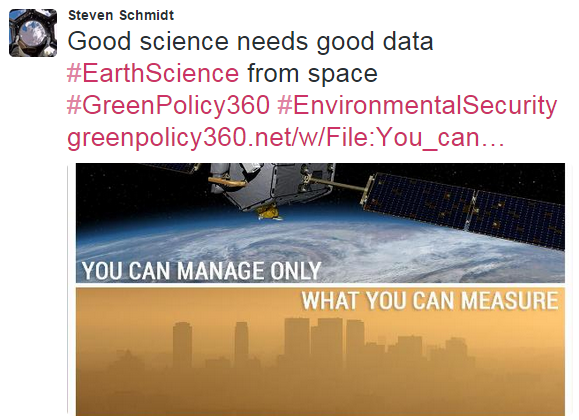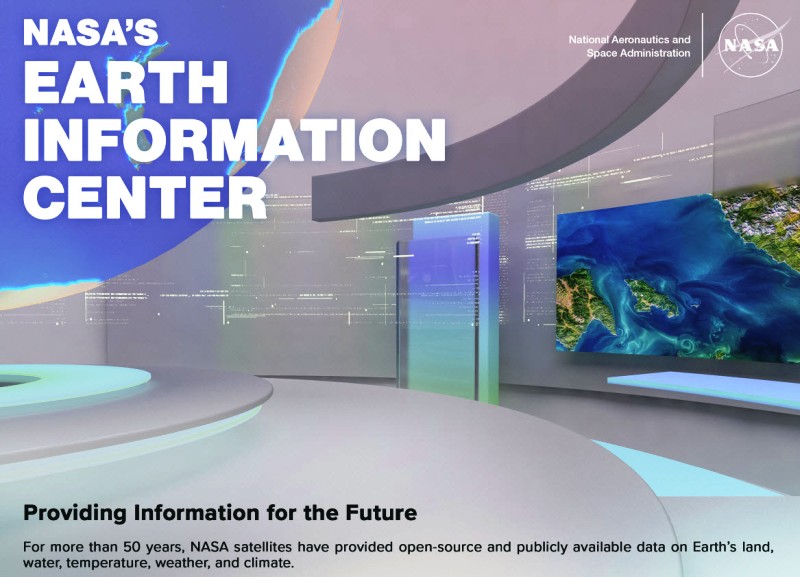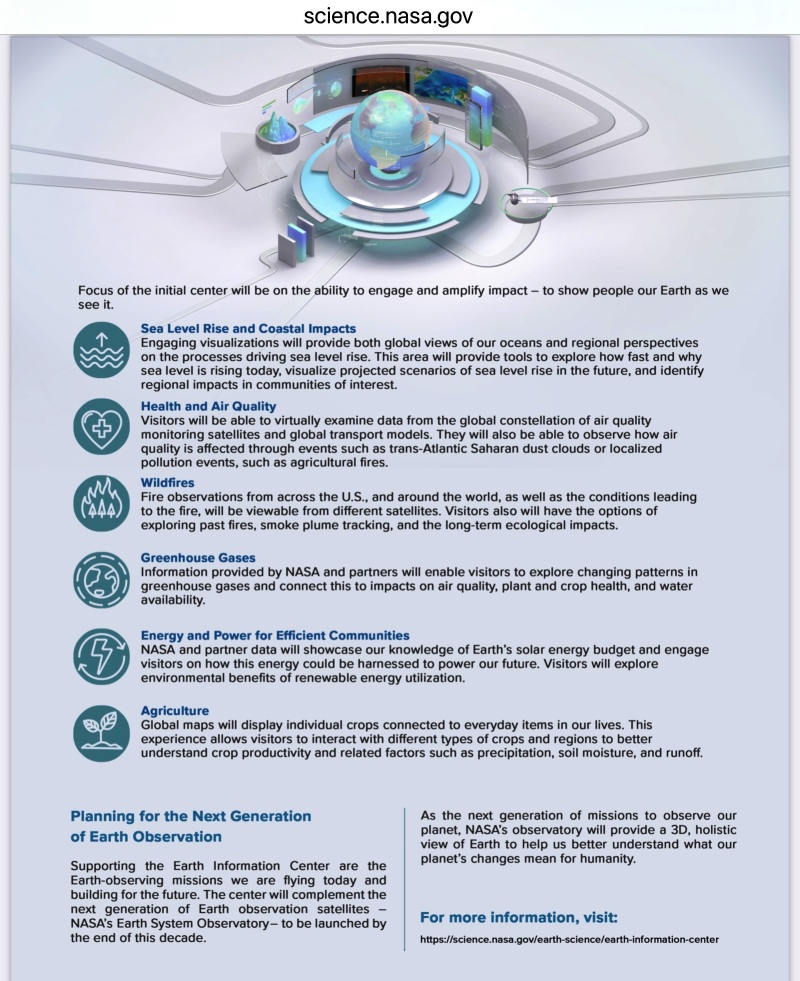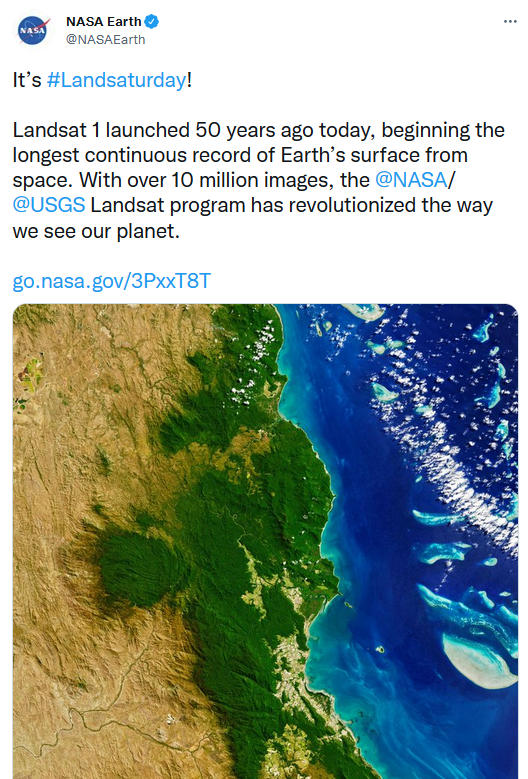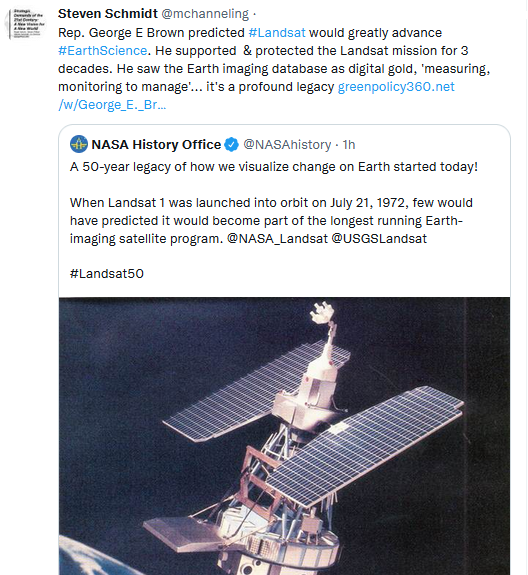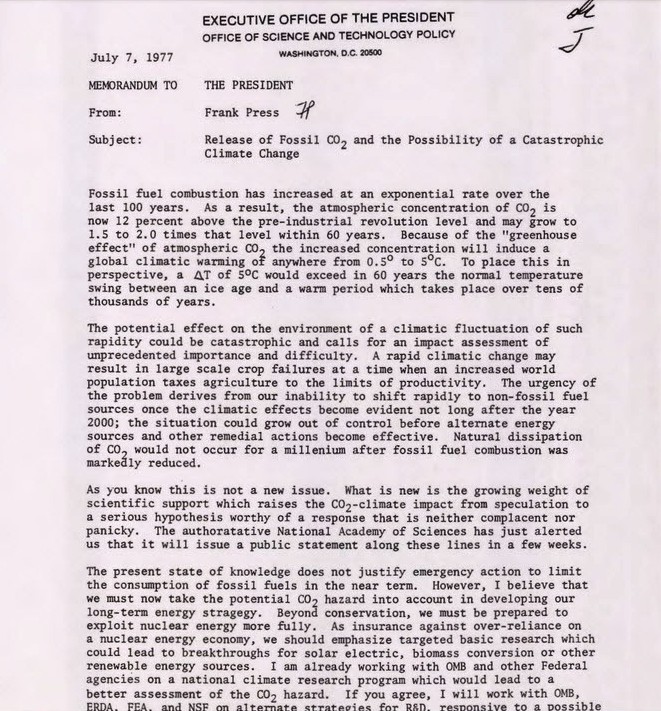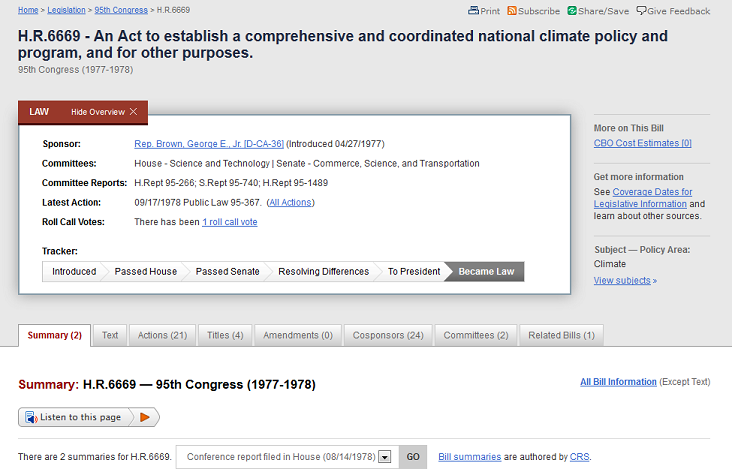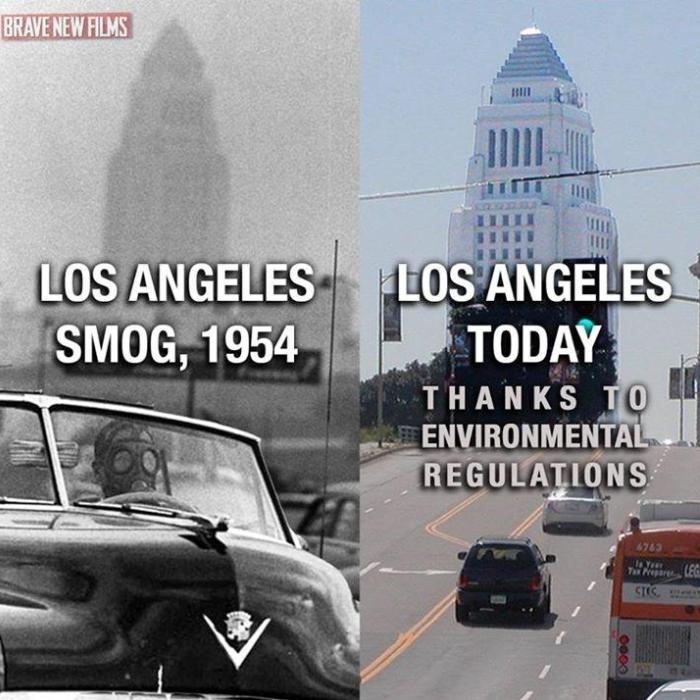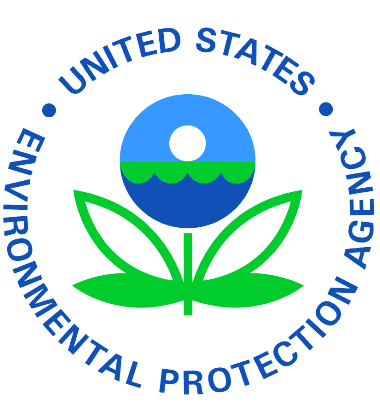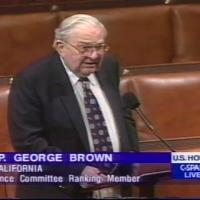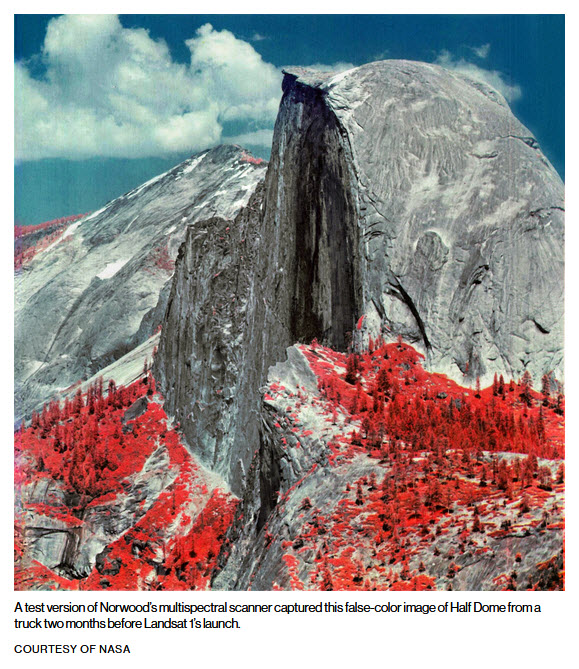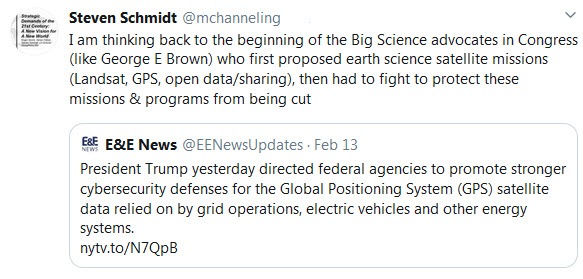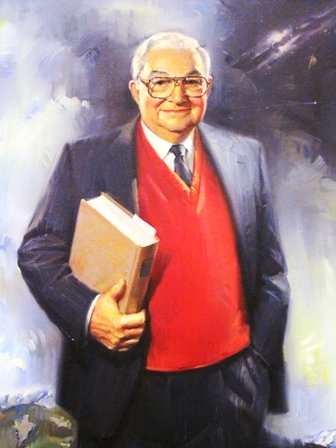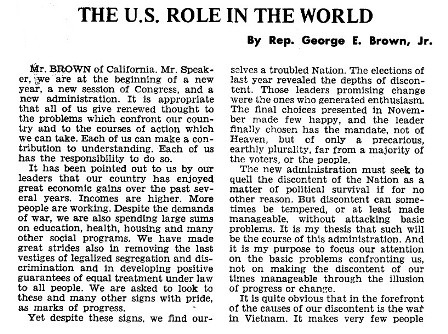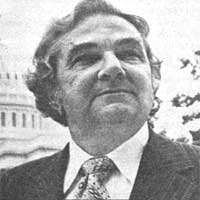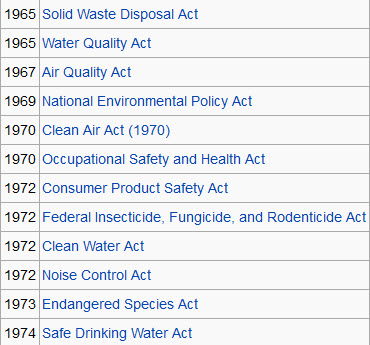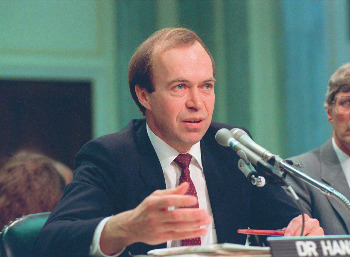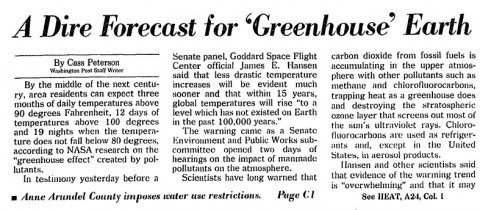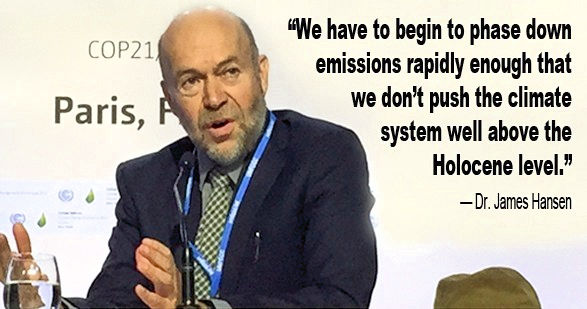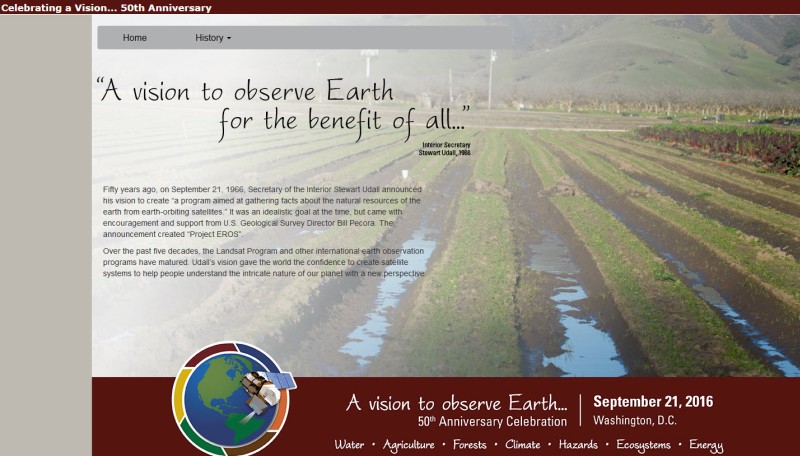George E. Brown Jr
Advancing Science, Facts, Technology and Data to Make the Case for Environmental Protection
- 1960s/70s, Beginnings of Planet Citizen Eco-Challenge and Evolutionary Change
Congressman George Brown: Visionary Leadership
- Historic Environmental Achievements, a Foundation for Today's National and Global 'Green' Movement
🌎
"My friend George"
By Steven Schmidt / GreenPolicy360 Siterunner
As a high school student, I met George Brown in the mid-1960s and we began to work, purposefully and closely, to make environmental protection a political reality.
George Brown changed the direction of my life and was integral to the founding of Earth Day in 1970 as he helped to set in motion my lifetime of environmental activism. George was looking forward to the 21st century, and especially to the challenges of environmental and earth science programs that he led in Congress for decades, until suddenly he passed away in 1999.
George was an amazing man, a visionary who was a mover in the U.S. Congress for four decades, beginning in the 1960s when we began our friendship and work together on a political journey. Let me dedicate this GreenPolicy360 page to Representative George E. Brown as both a biography and memorial. George will always be an influencer for me and his work and legacy is key to understanding my generation...
Even today, I can see George holding up the first of its type climate science report in the mid-1970s and then drafting the first National Climate Act -- https://greenpolicy360.net/w/File:US_Public_Law_95-367.png
I can see back to the beginning of an Earth Observation "Inventory" he envisioned when he was proposing and shepherding a new Landsat program into existence. I remember meeting, then years of learning, sharing and work alongside a congressman who set in motion and for decades advanced U.S. earth science research programs. George E. Brown was a special person who brought a physics and engineering background to Congress. George saw what others didn't really understand. Your GreenPolicy360 siterunner began to realize the future to come when our East LA Representative showed me the Mission Statement of NASA. -- “To understand and protect our home planet..."
Picture yourself like me, a young student in East Los Angeles meeting with a newly elected representative who was talking the "big picture". George, who became my friend and over the years a colleague, garnered a reputation in the 1970s/80s/90s as the "Big Science" guy in Congress. George was low key in his approach, but truly envisioned the need and went for what I soon began to see as "generational science".
From beginnings, the first Earth Day, with George along with me, and then thru years of politics and science, with foundational Earth Science missions like Landsat that George set in motion and oversaw in Congress, we shared plans, dreams, and stories. Many of the memories are recalled here at GreenPolicy360.
Beginnings of the Modern Environmental Movement
A First Earth Day
- Being there with George's assist, organizing
- Youth-energy eco 'Teach-ins' and events across the nation
I would later, after many years, begin to see our work as a picture of the early years of a Generation Green.
We were looking to protect our Living Earth.
* https://greenpolicy360.net/w/Planet_Citizen_Vision_of_Living_Earth
George E. Brown: Out-in-Front Leadership in Congress, 'Big Science' Vision to Confront Generational Challenges
- Decades of Environmental, Climate Science & Green Politics
Steve Schmidt / Founder, GreenPolicy360:
Our #GreenPolicy360 network thanks Representative George E. Brown.
The Congressman from California envisioned and led Earth Science initiatives in the US Congress.
George Brown saw, with his physics training and engineering background, what needed to designed.
The designs became planning, legislation, developing and organizing. George, quietly in his way, inspired.
The Earth Observing System (EOS)
The mission of the Earth Observing System that became a core element of the ongoing NASA earth science programs was first envisioned in the 1970s. The constellation of satellites that now comprise a connected matrix of ongoing earth imaging programs (see the latest here) came about as the U.S.
Congress realized in the years following NASA's establishment that Planet Earth was central to NASA's work. The initial NASA mission statement spoke of this study of Planet Earth as a key goal of NASA programs. A new science, space and technology Congressional Committee was created to envision and oversee these programs and one of the first realizations about the need for earth science came about through the LANDSAT program (see here). A historic moment brought into existence digital mapping, that is, multi-spectral imaging of earth from an orbiting satellite in space, envisioned and designed to collect and 'save' data of earth's living systems. This databank was considered to be essential by committee member George E. Brown who, as a physicist and engineer, began his three-decade + career in Congress. George eventually became known for his "big science" initiatives. What few knew back then at the beginning was how essential this data would become as climate science came into the light (in 1977 and '78 with George's work central to the drafting and passage of the first National Climate Act.)
In the 1980s, the Earth Observing System (EOS) work began in earnest.
NASA's Project Science Office years later described its beginning with this statement:
>Results from early missions shed light on critical components of the Earth system while prompting further, more advanced investigations. The NASA Earth Observing System (EOS) program was conceived in the 1980s and began to take shape in the early 1990s. EOS is comprised of a series of coordinated polar-orbiting satellites designed to monitor and understand key components of the climate system and their interactions through long-term global observations. The EOS missions focus on the following climate science areas: radiation, clouds, water vapor, and precipitation; the oceans; greenhouse gases; land-surface hydrology and ecosystem processes; glaciers, sea ice, and ice sheets; ozone and stratospheric chemistry; and natural and anthropogenic aerosols.
NASA's Earth Observing System (EOS) Reference Handbook
In June 1992, the National Space Policy Council issued National Space Policy Directive and EOS became part of a global change observation system.
Continuity of satellite missions gathering data over years established what is known as a longitudinal trendline of observations, the goal set forward in the late 1970s and 80s with LANDSAT, weather satellites and many others in the first generation of environmental science research with space-based remote imaging. This long vision would empower scientists and others to measure and monitor dynamic changes over time, a critical factor in enabling policies to be drafted to manage earth's systems. George Brown was a key factor in these decisions. He saw, as did your GreenPolicy360 siterunner who was following his work through the years, that data and sharing of data would build educational resources, science and new opportunities. Previous military intelligence programs from space, for example, were revisioned/rethought and ideas such as a Global Positioning System GPS with all of navigational potential on earth came into being under President Reagan in the 1980s. Later in the 1990s under Democratic administration the Next Generation Operational Control System acted toward increasing GPS positional accuracy. New mapping and navigation tools, now in most all new cars, were results of these programs that George Brown helped set in motion saw coming into existence before his passing away in 1999.
The Terra satellite, the first of 26 satellites that have orbited or continue to obit as a formal part of the EOS program was launched on Dec. 18, 1999. Terra (originally known as EOS-1) was designed for a five-year mission life, but continued to orbit for more than another decade.
George was alive as the launch of the Terra EOS program happened in December 1999. He knew that his mission, his work, was continuing on as a legacy.
We, at GreenPolicy360, tip our hat to the vision of a Planet Citizen, George E. Brown, a generational thinker and doer, a mover and shaker who created a legacy that carries on to today...
🌎
Five Decades in the Making: Climate Action
NY Times: Five Decades in the Making: Why It Took Congress So Long to Act on Climate
GreenPolicy360 responds:
Why has it taken so long for action to be taken on the Earth Science, the climate change facts, the data, that was revealed since the 1970s?
There were and there are headwinds arrayed against our forward progress...
Decades after the first National Climate Act in 1978 that Representative Brown drafted in the 1970s, climate action questions continue. Disinformation and misinformation array to block action on climate change.
Powerful opposition forces are at work. To reveal these forces look to the funders of these forces. 'Follow the Money', as the Watergate movie line intoned, is key to unlocking 'why' there has not been more action on climate.
June 2016 - Exxon Is Fighting for its Right to Deny Climate Change
- Exxon Bkrd | Exxon, the Road Not Taken | More States Attorneys General Support Investigation of ExxonMobil | Lamar Smith, Chairman, and Republican House Science Committee Oppose AGs Investigation of Exxon
🌎
Reflecting on the Life of George E. Brown
SJS / GreenPolicy Siterunner: Congressman George E. Brown was a man who convinced me to look at politics as a serious calling. When I was a young teenager in East LA in the 1960s looking out at a larger world in which I had yet to travel, I was debating "nuclear weapons proliferation" as the debate topic of the year being considered in high school. My young American generation carried with us memories of sirens warning of nuclear attack suddenly and loudly going off and forcing us to crawl under our desks in grammar school, George was the expert locally on world affairs, a Congressman I got to know in Monterey Park who was at the beginning of his career in politics, on the House of Representatives Science, Space and Technology Committee and already a respected voice in Washington DC.
For the next 35 years he was my mentor, then colleague and an inspiration of what can be done to make a difference and create a better world. George was a visionary with tousled hair, a professorial look, a smelly pipe and a twinkle in his eye. He was always there for his constituents, like me, an East LA kid who grew up to be a friend and cohort as we did green work over the years.
George was a real presence in Congress, in science and environmental achievements, from the first Earth Day to the first federal program to study climate science, from the first earth science research from space to 'big science' projects that carry on to this day.
Back in the early days, we would speak of these political efforts, and especially the immediate reality of the 'smog' in LA, which might have been at that time the worst in the world, and how we needed to clean up the air. I spoke of my asthma with George and his engineering background provided his perspective with advantages over the run-of-the-mill politicians in DC in knowing how to best address the pollution from cars, the gas engines that were becoming ubiquitous in fast-growing suburban Southern California.
When your GreenPolicy360 siterunner was in college at USC in the late 1960s and becoming deeply involved in politics, George and I continued to speak of the children in Los Angeles and their lung problems and scientific and medical studies that were vividly (shockingly) demonstrating the consequences of growing up in the most polluted air in the country.
George helped my organizing work and I helped his especially in the "decade of the environment" following the first Earth Day in 1970 and the building of a foundation of environmental legislation.
As George became a leader in Congress and ran for U.S. Senate, opposing the Vietnam war and I helped organize in DC what became the largest anti-war group, the Vietnam Moratorium Committee, we spoke of war and peace and how to change the nation's war policies and role in the world. His efforts to change U.S. foreign policy led to the first Earth Day.
- George Brown and Steve Schmidt, 1969
SJS: George Brown worked tirelessly in Congress. With saving and protecting the environment as key goals, George moved conservative and liberal politicians in new directions. George saw connections that transcended states and nations. He saw interconnections and new roles to protect health and safety. George was central in proposing and setting up an EPA as an umbrella agency to coordinate environmental federal and federal-state efforts (he pushed President Nixon to sign the EPA legislation)... George was a "first-mover" as the term has come to be known. He had a big-picture plan and set out to accomplish it. He succeeded on multiple fronts, pushing forward the idea and the vision for 'omnibus' legislation. The Environmental Protection Agency was founded and historic initial green laws and regulations for environmental protection and security were passed.
•
George was among the first voices to be raised warning about the environmental threat of climate disruption and, although few realize, he was at the forefront of the initial efforts to study the climate, pushing the development of initial atmospheric science programs and missions of NASA and public/private research. He combined his engineering skills with his legislative reach.
George E. Brown, in fact, drafted the "National Climate Program Act" of 1978.
1978 Climate Act PDF via GreenPolicy360
•
Rep. George Brown brought his extensive work with U.S. top scientists, featured in the work of 1977's Energy and Climate Report of the National Academy of Sciences and follow on 1979 Academy Climate Science Report that along with the 1979 Charney Report were presciently accurate in climate change predictions.
The Congressman-Engineer emphasized, constantly to me and in his work, the essential importantance of having accurate data in order to make the best possible engineering decisions. He imprinted, if I could use this word to its fullest meaning, * the vital nature of gathering information with studies over time to monitor changes*. George Brown was in an oversight position on one of the most powerful committees in government and he acted with vision to shape the policies of science -- atmospheric science, earth science, big science.
Whenever we see the NASA 'marching directive' "You can manage only what you can measure", think of George. The original mission statement of our nation's first ventures into space began with studying the home planet. Measuring and monitoring became a mantra of Earth Science...
Congressman George Brown left us a legacy of vision and action against threats to the atmosphere, earth's life systems, and sustainability.
We have, all who believe in the importance of science, carried forward his thoughts over the years since the 1960s and 1970s. As best we could, we have carried on against deep odds and opposition by those with other goals.
•
The Mission Statement of NASA provided Congressional intent and guidance to the first generation of space programs. GreenPolicy360's founder heard him speak often of the 'home planet' mission of NASA. I am certain that George, if he were still here, would be doing everything within his power to protect the Earth Science mission... George believed strongly that the Earth Science of NASA, and agencies such as Landsat's USGS, and all the related educational, scientific, and business organization were essential to protect our lives today and in the future.
Andrew Revkin/July 22, 2006/ NY Times re: the original NASA space program mission statement:
“To understand and protect our home planet; to explore the universe and search for life; to inspire the next generation of explorers ... as only NASA can.”
In February 2006, the phrase "to understand and protect the home planet" was quietly removed from the National Aeronautics and Space Administration (NASA)'s official mission statement.
•
Atmospheric Science
- Earth Science to Protect & Preserve a Sustainable Earth
- Back to the Beginnings: Earth Science, New Visions of Security
- Time to act to make a positive difference
Planet Citizens, Planet Scientists, Preserving & Protecting the Home Planet Earth
GreenPolicy360 Siterunner / SJS: In the 1960s and 1970s, Representative George E. Brown proposed and set in motion a first generation of Earth Science missions and programs that continued over the decades. When one looks at today's Earth Science Research from Space and accumulative science data acquired over the decades, we are seeing the results of George's vision. As an engineer with a physics background, he knew we would need good scientific data to make the decisions guiding how we respond to the great challenges of our times, the existential threats on multiple fronts, and we are tapping into the results of programs designed to produce the knowledge base George Brown knew would be needed to make wise decisions. Whether we make the necessary decisions is up to our generation. Every generation has a 'generational responsibility' as we, at GreenPolicy360 see the challenges all of us must face, as Planet Citizens. George Brown was first to see and act as he drafted the National Climate Program Act legislation in 1978. He pushed to set up a new Science and Technology Office to press President Carter on the climate change danger (see their letter, attached here, and he continued to support and press forward with an array of scientific research programs and missions with vision over the 1980s and 1990s.
GreenPolicy360's founder was fortunate, beginning in the 1960s, to listen to Congressman Brown Congressman George E. Brown point to the NASA plan and explain how he saw Congress put into action the reality of a multi-year, coordinated, multi-agency program to achieve mission goals.
Earth science, measuring and monitoring Earth's life-enabling systems was given highest priority. Landsat's program was set in motion as a decades long, first-ever digital scanning remote satellites data collecting study. An array of satellites began to launch, creating and combining the expanding resources of NASA, USGS, NOAA, and an array of educational and scientific institutions and aeronautics business.
Fifty+ Years On
Update: July 2022
The overall goal, Representative Brown would continue to explain in his Congressional Science, Space & Technology leadership roles over the decades, was to understand, preserve and protect our planet as we, humanity, develop the science to look beyond the Earth and study 'the heavens'. The Earth Science data, imaging of the home planet, was intended to be a trove for today's research of Earth's connected life-supporting systems and a 'longitudinal study', a timeline tracking dynamic changes in Earth systems over the years...
Here's to George Brown and the many visionaries, thinkers and doers who have carried on preserving and protecting our home planet.
As George and I worked over many years we both grew in our politics as together and separately we advocated for peace and environmental protection. Big science was at the center of much of George's future-looking agenda. He believed in green politics and was a mentor to me and many.... He became a leader in Congress from California who helped shape the modern environmental movement.
California out in front in a Green future
Today many of the actions of George Brown continue as models for citizens, cities and nations of the world. California and a green political/environmental protection movement that George helped to begin continue to be out in front with ideas to improve quality of life.
In our GreenPolicy360 work, George's work continues. Even as political opposition to environmental work, anti-nuclear work, anti-war work is at risk, as we look out at a strategic horizon with pressing demands, the foundations put in place by an earlier generation remain strong.
Planet Citizens | Planet Citizens, Planet Scientists
George Brown's work remains with us in his legacy of accomplishment. I miss him often but know he is still around as the constellation of Earth science missions and program first envisioned and launched with George's hands on guidance, generational initiatives that I witnessed, continue on through the years. We now have, as a result, essential baselines, databases, generation-to-generation measuring and monitoring of Earth's living, changing systems. I feel George's advice when I write of green ideas and look to our children, education and our shared future...
Let's look at some of what George accomplished before his untimely passing in 1999:
(LA Times, July 17, 1999) Brown’s true passion was science and technology. He was an early advocate of protecting the deteriorating ozone layer and developing solar power. He championed the creation of the federal Environmental Protection Agency.
Sierra Club Executive Director Carl Pope said it was fitting that the final bill introduced by Brown was the Sequoia Protection Act to eliminate commercial logging and mining in areas of Sequoia National Forest.
“From my earliest days, I was fascinated by science,” Brown told the New York Times earlier this year. “I was fascinated by a utopian vision of what the world could be like. I’ve thought that science could be the basis for a better world, and that’s what I’ve been trying to do all these years.”
George was instrumental in proposing and establishing the Presidential Office of Science and Technology Policy in 1976. He was working alongside the National Academy of Sciences as they released a first-ever climate report in 1977. In 1977 he and the new Office of Science and Technology sent a first government warning of "climatic fluctuation" and "catastrophic" change to President Carter:
Congressman Brown Out in Front of Climate Action
At the Beginning of U.S. Science on Global Warming, Strategies & Planning
1978, the First Climate Actions
In 1979 came the first follow-on National Science Academy report. This study and report of national scientists was prescient and accurate in its global warming predictions.
First National Climate Act, Historic Work, 1978
GreenPolicy360 Siterunner / SJS: The beginnings of modern environmental and climate science can be traced to the 1960s and 1970s. The U.S. National Academy of Sciences played a key role in laying a foundation of scientific reports and data.
Energy and Climate Report, 1977, National Academy of Sciences / 175 pp. / PDF via GreenPolicy360
Rep. George Brown took the findings of the 1977 Energy and Climate Report from the Academy of Sciences and made the science actionable. In a historic moment, he proposed and drafted the legislation of the first U.S. National Climate Program and shepherded its passage in 1978.
This first federal program established to study and assess scientifically the issues and risks of human-caused climate change became a foundation for comprehensive initiatives, with an array of new Earth Science missions led by NASA and NOAA, the EPA and USGS.
○
In his rumpled suits and quiet way George E. Brown moved to form coalitions few thought could be formed and garnered support for the first set of U.S. Congressional acts that served as foundation legislation for decades of green progress.
The First Earth Day: Personal Memories by Steven Schmidt of George's Role
Congressman Brown's work advanced environmental air quality and clean air legislation. He introduced the nation's first bill to ban lead in gasoline and was at the forefront of the Clean Air Act. He attacked Los Angeles smog, some of the worst air quality of any city in the world at the time and the air standards that came out of California became models worldwide. He succeeded in clean air and water efforts, though rarely given credit given his quiet approach to accomplishing big picture goals.
- A Historical Perspective on Its Role in Environmental Protection
Representative George Brown was a key player in legislation founding the Environmental Protection Agency.
As the LA Times noted (without pomp or circumstance) in George's obituary in 1999: "He championed the creation of the federal Environmental Protection Agency". The creation of the EPA was in many ways Congressman George Brown's vision achieved..."
The founding of the EPA was based on new realizations of science and the environment. The vision of the "Whole Earth" that began with unprecedented Apollo photos on the cover of Life magazine in January 1969 led to a coming together of education, students 'teach-ins', scientific space missions studying earth systems for the first time, and popular demands for environmental protections.
A leader and a chairperson on the House science committee for over 30 years, George legislatively engineered an array of science efforts, including one that greens look to as prescient -- climate science.
From California to the World
GreenPolicy360 Siterunner: In the early years of the modern environmental movement, a conscious effort was made to construct a foundation of environmental laws and regulations on which a multi-year environmental protection framework could be built. Your GreenPolicy360 founder was one of those who believed in this constructive paradigm, using model legislation that could be locally developed, often in our state of California, then shared, 'exported' as we used to say, 'to the Feds' for adoption at the national level. The history here provides an ongoing modus operandi from the 60s and 70s until now as we deal with the pressing local, national, and international/global environmental threats and crises. We, at GreenPolicy360, call this "green best practices". Best practices is a model for sharing, networking, building on success and action. Templates and models, best practices made openly available, are our plans for having multiplier effects -- and it is our ongoing mission. A strong and resilient legal foundation and framework of environmental laws is an essential part of our overall work. We encourage you to join in as citizens of every nation, within your multiple and diverse legal systems and, we must add, as planet citizens.
When Congressman Brown drafted originating legislation establishing a national climate change research program via the National Climate Program Act of 1978, the scientific community and nation were just beginning to awaken to a new national security threat. I remember his concern, our concern. He was trained as a scientist, an engineer, with an ability to see facts and data sets in a way others could not.
Representative Brown was out in front of "Big Science". In his decades on the House Science, Space & Technology Committee, he worked to expand the reach of science. He knew that good data enabled good policy decisions. He pressed for first-generation earth science satellites and ongoing earth monitoring missions and data sharing.
Among his many initiatives, George Brown was a key figure in proposing, establishing, and then saving the Landsat program and its unique 'open-access' database of Earth Science imaging when President Reagan attempted to shut Landsat down. Landsat was a model for all the following earth science research missions from space and is now moving into its fifth decade with Landsat 9.
Earth Science Research from Space
- Landsat and Virginia Tower Norwood
Among his many initiatives, George Brown was a key figure in proposing, establishing, and then saving the Landsat mission and its decades of earth science programs. Landsat's unique 'open-access' database of Earth Science imaging profoundly changed the way we see our home planet. The Landsat mission's earth science, thanks to visionaries like George E. Brown and Virginia Tower Norwood, created a digital and dynamic database documenting earth's changes over decades. When science naysayers and politicians such as President Reagan attempted to end the Landsat mission budget and shut the Landsat program down, George Brown intervened and led the opposition. Landsat's earth science technology continued to be a model for all earth science research missions from space and is now moving into its fifth decade with Landsat 9.
Earth/Space Science, Landsat Update: April 2021
SJS/GreenPolicy360 Siterunner:
A tip of our GreenPolicy360 hat to George E. Brown Jr who envisioned the Landsat's mission, the beginning of earth imaging and open access to the data and as a science leader in the US Congress supported, expanded and protected the earth science mission over the decades. The launch now, in April 2021, of Timelapse by Google Earth realizes a next step in George's decades-long quest to bring knowledge of our home planet to all citizens.
Climate Change - Global Warming Keyword-Terms
Rebecca Moore: "This work was possible because of the U.S. government and European Union’s commitments to open and accessible data. Not to mention their herculean efforts to launch rockets, rovers, satellites and astronauts into space in the spirit of knowledge and exploration. Timelapse in Google Earth simply wouldn’t have been possible without NASA and the United States Geological Survey’s Landsat program, the world’s first (and longest-running) civilian Earth observation program, and the European Union’s Copernicus program with its Sentinel satellites."
Timelapse from Google Earth
Welcome to Timelapse!
Rebecca Moore, Director, Google Earth, Earth Engine & Outreach:
To explore Timelapse in Google Earth, go to g.co/Timelapse — choose any place on the planet where you want to see time in motion.
Launch Date: April 15, 2021
- 🌎
Thirty plus years setting the agenda for visionary science
- Congressman Brown's Official Portrait
- House Committee on Science, Space, and Technology Hearing Room
At the beginning of the 'space race', the House Committee on Science and Aeronautics was created by the 85th Congress in 1957 to oversee the newly-created National Aeronautics and Space Administration (NASA). The Science and Aeronautics Committee was the first committee since 1892 to be established for an entirely new area of jurisdiction. The committee’s jurisdiction over the years has expanded to include most civilian non-medical scientific research throughout the government, including National space policy, Earth remote sensing policy; Space commercialization, including commercial space activities relating to the Department of Transportation and the Department of Commerce, the National Science Foundation, the Energy Department, the National Institute of Standards and Technology (NIST), EPA, NOAA and the Department of Homeland Security. (Informally known as the Science committee, the committee's name was change to the "Committee on Science and Technology" in 1974. At that time, the Committee’s jurisdiction was expanded to include legislation related to energy, the environment, the atmosphere, civil aviation research and development, and the National Weather Service. The Committee on Science and Technology was also given a "special oversight" function providing for exclusive responsibility among all Congressional Standing Committees to review and study, on a continuing basis, all laws, programs and government activities involving Federal non-military research and development. In its early years, the Committee was an important partner in the Apollo Program that led to a man landing on the moon and strengthening science education and scientific research. After the Committee’s role expanded, the Committee has played an important role in much of the legislation Congress has considered dealing with domestic and international science, technology, standards, and competitiveness. In the 112th Congress, Chairman Hall changed the Committee's name to the "Committee on Science, Space and Technology."
○ ○ ○ ○ ○ ○ ○ ○ ○ ○ ○ ○ ○ ○ ○ ○ ○ ○ ○ ○ ○
Via Wikipedia / https://en.wikipedia.org/wiki/George_Brown_Jr.
Brown was known as a champion for science. He left behind a deep and expansive legacy that has shaped science and science policy in America. Among some of his many accomplishments during his service on the House Science Committee:
• Established the first federal climate change research program in the Federal Climate Program Act of 1978
• Established the Office of Science and Technology Policy
• Established the Environmental Protection Agency
• Established the Office of Technology Assessment
○ ○ ○ ○ ○ ○ ○ ○ ○ ○ ○ ○ ○ ○ ○
'Existential' Questions, Nuclear Risks
George, as chairman of the House of Representatives Committee on Science, Space, and Technology, over the years until his sudden death in 1999 played a key role in nuclear weapons oversight. As with the National Climate Act he drafted in the 1970s identifying global warming as a serious, even existential threat, his focus on the threat from his first year in office in the early 1960s saw him leading efforts to reduce the nuclear stockpile and reducing the imminent threat of global destruction. The Congressman's work on non-proliferation stands out. George's letter to the head of the Department of Energy in February 1992 remains a testimony to the need for a new "strategic plan" for the Department of Energy (DOE) nuclear weapons labs.
○ ○ ○ ○ ○ ○ ○ ○ ○ ○ ○ ○ ○ ○ ○ ○
As the Cold War Ends
- A "Peace Dividend" and a New Strategic Vision Are Within View
Congressman Brown singled out nuclear weapons as the Cold War came to an end. Alternatives were envisioned, opportunities for nuclear weapons reductions, safeguards, re-thinking the theory of "mutually assured destruction" (MAD) policies that dominated from the 1950s through the end of the Soviet Union. Your GreenPolicy360 editor, at that time, was often in communication with the Congressman on this issue, as I also worked alongside Governor Jerry Brown in formulating the presidential campaign platform of our campaign in 1992.
Nuclear issues were top of mind, as were nuclear reduction efforts, non-proliferation and treaties to reduce nuclear stockpiles and build monitoring conventions. George assisted many public interest groups in nuclear oversight work, such as the Los Alamos Study Group. The Congressman's quest to promote peace and comprehensive security, a focus of his 'big picture' thinking, was prominent during the 1990s.
George Brown / Speaks On Nuclear Weapons
File:George Brown letter-1992 to US Energy Dept-nuclear weapons future.pdf
George believed that strong advocacy was needed as the Cold War was ending with the fall of the Berlin Wall and soon thereafter with the collapse of the Soviet Union. The Congressman's respected views on nuclear non-proliferation, his concern for decades, were potentially realizable, he believed, during this unique 'window of opportunity'. He advanced far-reaching ideas for nuclear weapons controls and international nuclear agreements. In these last years of the Congressman, before his death in 1999, he attempted to turn his visionary ideas for nuclear disarmament into reality.
The "Endgame" of US-Russian negotiations, as described in Strobe Talbott's negotiations during the US/Clinton administration, with a series of setbacks during this period, are a matter of history.
A proverbial window opened -- a 'give peace a chance' moment was possible, a peace dividend was possible, a new vision was possible, then the window of opporunity closed.
○ ○ ○ ○ ○ ○ ○ ○ ○ ○ ○ ○ ○ ○ ○ ○ ○ ○ ○ ○ ○ ○ ○ ○
George E. Brown Jr. --- East L.A. to 'Planet Citizen'
George's Obituary
Born: March 6, 1920 - Died: July 15, 1999 (aged 79)
Los Angeles Times, July 17, 1999
George's Memorial Service / C-Span
○ ○ ○ ○ ○ ○ ○ ○ ○
A Conversation with George E. Brown Jr.
- The Congressman Who Loved Science
Mr. Brown, 79, has been a crucial supporter of manned and unmanned space exploration. He was an author of legislation creating the Environmental Protection Agency, a prime mover behind efforts to include ozone layer protections in the Clean Air Act...
"From my earliest days, I was fascinated by science," Mr. Brown said in his offices on Capitol Hill, his wife, Marta, at his side. "Also by my earliest days, I was fascinated by a utopian vision of what the world could be like. I've thought that science could be the basis for a better world, and that's what I've been trying to do all these years."
○ ○ ○ ○ ○ ○ ○ ○ ○ ○ ○ ○ ○ ○ ○ ○ ○ ○ ○ ○ ○
George Brown goes deeper Green
Recollections from 1977
Not many U.S. Congressmen can claim to have an "integral urban district office" complete with solar heating and cooling, a lean-to greenhouse, and bee-hives. Representative George E. Brown, Jr. (D-Calif.) can, however ... because he does have just such office facilities.
Two years ago — when Congressman Brown decided that he wanted solar heating for his Colton, California office building (an old house located in a semi-residential part of town) — he asked his staff to design and install a low-cost, low-technology heating system by themselves. He told his aides that they were free to seek expert advice, but that they should attempt to do as much of the actual construction as possible.
So while Brown was away in Washington, his staffers outfitted the building with an air-handling, "active" solar heating setup that employs a single large wood-and-fiberglass solar collector and a bin loaded with 13 tons of rock for heat storage ... a setup that — so far — has provided virtually 100 percent of the office building's winter heating needs. (The same system can be used to provide cooling during the summer, although — because of the desert-like temperatures that hit the area during the summer months-supplemental cooling must also be used.)
In back of the aging office structure, Brown's aides built a lean-to "solar greenhouse" that furnishes the main house with additional solar heating and provides the Congressman's staff with a year-round supply of fresh vegetables.
A year or so ago, Brown's staff members decided they wanted to "raise" honey as well as vegetables ... so they "coaxed" a swarm of bees into an empty hive, and within six months harvested 100 pounds of the golden sweetener!
Because of the great amount of public interest in these and other of the Congressman's activities, Brown recently encouraged the Agricultural Division of the University of California's Cooperative Extension to apply for federal funding to open a community food preservation center in nearby Riverside, California. The application was approved.
If it has to do with living-better-for-less alternatives, chances are the honorable George E. Brown, Jr. knows about it ... or is already doing it!
-- Linda Martin / Mother Earth News
○ ○ ○ ○ ○ ○ ○ ○ ○ ○ ○ ○ ○ ○ ○ ○ ○ ○ ○ ○ ○ ○ ○ ○ ○ ○ ○ ○ ○ ○ ○ ○ ○ ○ ○
The Beginnings of the Environmental Protection Agency
- Trump administration removes data, attempts to 'scrub' information about the EPA
- Trump administration attempts to end earth science missions of NASA as part of a larger rollback of environmental protections
• http://www2.epa.gov/aboutepa/epa-order-11102 (page removed during Trump administration...)
• http://www2.epa.gov/aboutepa/birth-epa (page removed)
• http://www2.epa.gov/aboutepa/guardian-epas-formative-years-1970-1973 (page removed)
○ ○ ○ ○ ○ ○ ○ ○ ○ ○ ○ ○ ○ ○ ○ ○ ○ ○ ○ ○ ○ ○ ○ ○ ○ ○
The George E. Brown, Jr. Archive at the University of California
"Congressman, a visionary who championed the environment, alternative energy, human rights and education. When he died in office in 1999 at the age of 79, he left a legacy that included establishment of the Environmental Protection Agency, the Office of Science Technology Policy, Section 8 housing for low-income people and scholarships for veterans."
Details of that legacy – from his first political post as mayor of Monterey Park, Calif., to his chairmanship of the House of Representatives Science Committee – survive in 525 boxes and nine file cabinets of personal papers donated recently to the University of California, Riverside by his widow, Marta Brown...
- ○ ○ ○ ○ ○ ○ ○
• http://www.greenpolicy360.net/w/Environmental_movement
• George Brown on the Omnibus Environmental Bill, 1969
• https://www.greenpolicy360.net/w/Ethics_and_Climate_Change
• @GreenPolicy360, 'The beginning of the modern environmental era'
SJS/GreenPolicy Siterunner:
Unprecedented environmental protection, a vision that began a process that continues to this day...
Green, environmental public policies, a foundation on which to build sustainable quality of life...
Water quality act
http://www.encyclopedia.com/article-1G2-3456400109/water-quality-act-1965.html
Air quality act http://scholarship.law.duke.edu/cgi/viewcontent.cgi?article=3197&context=lcp
National environmental policy act http://en.wikipedia.org/wiki/National_Environmental_Policy_Act
Clean air act (extended 1970) https://www.gpo.gov/fdsys/pkg/STATUTE-84/pdf/STATUTE-84-Pg1676.pdf
Occupational safety and health act http://en.wikipedia.org/wiki/Occupational_Safety_and_Health_Act
Consumer product safety act http://en.wikipedia.org/wiki/Consumer_Product_Safety_Act
Federal insecticide, fungicide and rodenticide act http://www.epa.gov/agriculture/lfra.html
Clean water act http://en.wikipedia.org/wiki/Clean_Water_Act
Noise control act http://en.wikipedia.org/wiki/Noise_Control_Act
Endangered species act http://www.fws.gov/endangered/laws-policies/
Safe drinking water act http://water.epa.gov/lawsregs/guidance/sdwa/basicinformation.cfm
○ ○ ○ ○ ○ ○ ○ ○ ○ ○ ○ ○ ○ ○ ○
1988, a History-making Senate Hearing
James Hansen's Warning to Congress in 1988:
- Ten years after the National Climate Program Act was drafted by Representative Brown and the Climate Act's passage in 1978 that began the federal government's action and further study of climate change, impacts and risks, Professor Hansen strongly warns the US Senate of the rising danger of climate change.
- More re: James Hansen's testimony to Congress in 1988, thirty years on ...
- 1981
○
Note: June 3, 2016
Siterunner / SJS: As a member of the Wiki community, we/GreenPolicy are presently acting to update the Wikipedia biography of Congressman George E. Brown. The following update expresses our point of view and current communications with Wikipedia.
GreenPolicy Siterunner / June 2, 2016: I'm corresponding w/ a Wikipedia editor to update George E Brown's bio -- some changes are made and this one below is now under consideration - basically I want them to add the Congressman's central role in proposing/drafting key environmental legis that began the modern envir movement, including drafting this statute, the beginning of the Federal climate change research program in 78, no inconsiderable accomplishment considering what is at stake.
GreenPolicy Siterunner: Here are a few lines that I wrote to the corresponding Wikipedia editor re: the George Brown listing:
>The Congressman served for more than 30 years on the House Science Committee. See the last paragraph here, a NY Times citation:
>Consider this quote from the NY Times (a few months before his death in 1999):
>George Brown was an author of legislation creating the Environmental Protection Agency, a prime mover behind efforts to include ozone layer protections in the Clean Air Act and an advocate of restructuring the national weapons laboratories to meet the needs of a peacetime economy.
>Also re the current Wikipedia bio wording >Among some of his many accomplishments during his service on the House Science Committee:
>>Established the first federal climate change research program in the Federal Climate Program Act of 1978
>In fact George Brown was the principal author of the initial legislation and leader on climate change/policy
Considering the importance of this subject, climate change, I'd recommend wording that is more exact -- eg, "author of legislation that established..." and adding a link to the exact Legislative Bill ie, Public Law 95-367 https://www.gpo.gov/fdsys/pkg/STATUTE-92/pdf/STATUTE-92-Pg601.pdf.
Adding specific language about Representative Brown's drafting the bill is historically important and would be more precise than "during his service on the House Science Committee"... "established the first federal climate change program..."
○
Over the years George Brown worked alongside California legislators and political leaders to push a new environmental agenda. In his powerful roles out in front of the the US House of Representatives, especially on science and environment, George created a legacy.
George Brown and California Governor Jerry Brown allied in many initiatives and legislative efforts that led the nation, states -- and the world -- in shaping a visionary environmental record. California's 'out in front' achievements as a leader in environmental work and model green policies and practices continue forward, watched and replicated by countries, states and communities globally.
Here is a tip of the hat with lasting respect to George Brown, and Jerry Brown, and science, and environmental green visionaries around the world.
○
https://landsat.gsfc.nasa.gov/
'https://www.greenpolicy360.net/w/Virtual_Earth
'http://www.greenpolicy360.net/w/Landsat_data_users_handbook
Thank you George for LANDSAT and for all your accomplishments
50th Anniversary of Landsat in 2016
December 28, 2018
GreenPolicy360 Siterunner: William Westermeyer writes of a science agency that was established thru the work of Congressman George E Brown, Congressman from East LA and a leader of California's initiatives in environmental science. Over the years, the science and technology office has put forward by Congressman Brown has continued to be available to advise the president, Office of Science and Technology Policy yet currently, in the Trump presidency, it is is moribund with its science executive positions going unfilled by the president.
President Trump is on record saying he doesn't need the science and he has called global warming a "hoax" on multiple occasions. The head of the government agency that monitors climate change says that he has never discussed the issue with the current U.S. President, Donald Trump. Acting National Oceanic and Atmospheric Administration (NOAA) chief Adm. Timothy Gallaudet: "I personally have not briefed the president on climate change."
The nation, and world, heads into 2019 as science and guidance of visionary leaders are set aside.
• https://www.greenpolicy360.net/w/Climate_News
• https://www.greenpolicy360.net/w/George_E._Brown_Jr
··································································
On the 50th Anniversary of the Apollo 8 Mission in 2018 ...
"Earthrise" ... Whole Earth vision and the beginning of the modern Environmental Movement
December 24, 2018
Via CNN / Fifty years after "Earthrise"
Via USA Today / "Earthrise" on the Fiftieth Anniversary
• https://www.greenpolicy360.net/w/File:Apollo.jpg
• http://www.bbc.com/future/story/20181220-the-nasa-mission-that-broadcast-to-a-billion-people
- 'Earthrise'
- Planet Citizen
- Planet Citizens
- Planet Citizens, Planet Scientists
- Air Pollution
- Air Quality
- Anthropocene
- Atmosphere
- Atmospheric Science
- Biodiversity
- Citizen Science
- Clean Air
- Clean Water
- Climate Change
- Climate Policy
- Democracy
- Earth
- Earth360
- EarthPOV
- Earth Day
- Earth Imaging
- Earth Observations
- Earth Science
- Earth Science from Space
- Earth System Science
- Eco-nomics
- Ecological Economics
- Ecology Studies
- Environmental Laws
- Environmental Protection
- Environmental Security
- Environmental Security, National Security
- EOS eco Operating System
- ESA
- Gas-Powered Transportation
- Global Security
- Global Warming
- GreenPolicy360
- Green Politics
- Housing
- Maps
- NASA
- Nature
- Natural Resources
- New Definitions of National Security
- NOAA
- Nuclear Nonproliferation
- Nuclear Proliferation
- Nuclear Weapons
- Oceans
- Peace
- Planet API
- PlanetLabs
- Pollution
- Radioactive Pollution
- Resilience
- Rivers
- Strategic Demands
- Sustainability
- Sustainability Policies
- Toxics and Pollution
- US Environmental Protection Agency
- Water Quality
- Whole Earth
- Youth
